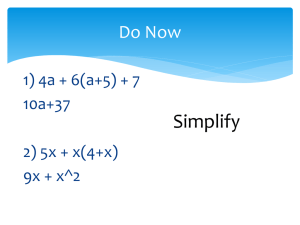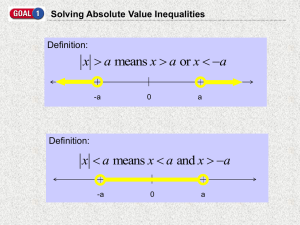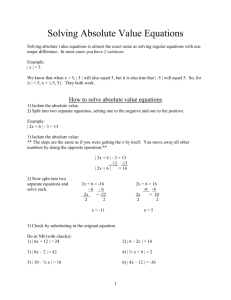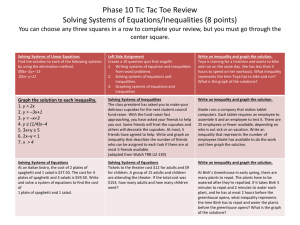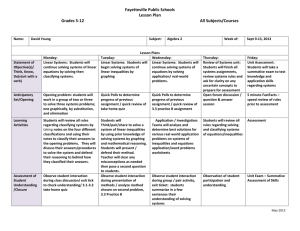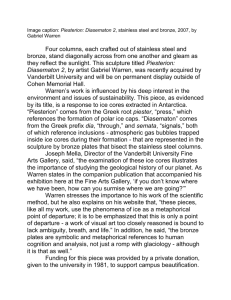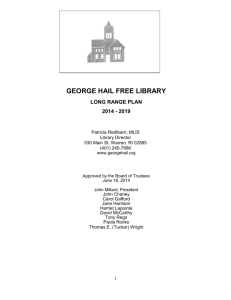Example 1
advertisement
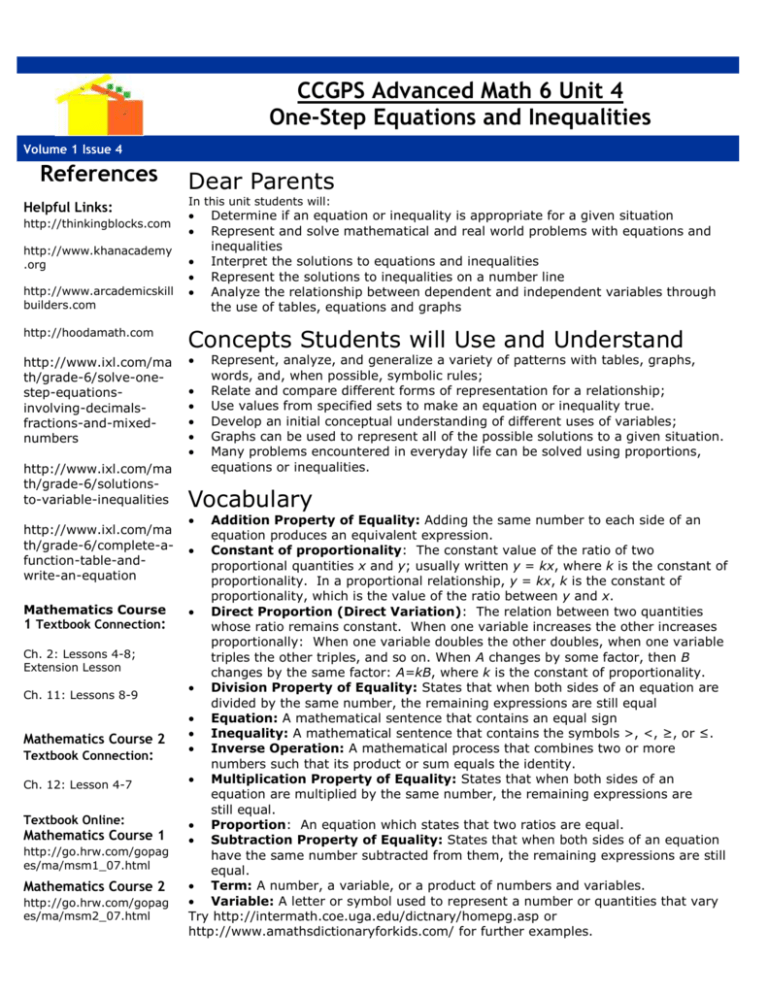
CCGPS Advanced Math 6 Unit 4 One-Step Equations and Inequalities Volume 1 Issue 4 References Helpful Links: http://thinkingblocks.com http://www.khanacademy .org http://www.arcademicskill builders.com Dear Parents In this unit students will: Determine if an equation or inequality is appropriate for a given situation Represent and solve mathematical and real world problems with equations and inequalities Interpret the solutions to equations and inequalities Represent the solutions to inequalities on a number line Analyze the relationship between dependent and independent variables through the use of tables, equations and graphs http://hoodamath.com Concepts Students will Use and Understand http://www.ixl.com/ma th/grade-6/solve-onestep-equationsinvolving-decimalsfractions-and-mixednumbers http://www.ixl.com/ma th/grade-6/solutionsto-variable-inequalities http://www.ixl.com/ma th/grade-6/complete-afunction-table-andwrite-an-equation Mathematics Course 1 Textbook Connection: Ch. 2: Lessons 4-8; Extension Lesson Ch. 11: Lessons 8-9 Mathematics Course 2 Textbook Connection: Ch. 12: Lesson 4-7 Textbook Online: Mathematics Course 1 http://go.hrw.com/gopag es/ma/msm1_07.html Mathematics Course 2 http://go.hrw.com/gopag es/ma/msm2_07.html Represent, analyze, and generalize a variety of patterns with tables, graphs, words, and, when possible, symbolic rules; Relate and compare different forms of representation for a relationship; Use values from specified sets to make an equation or inequality true. Develop an initial conceptual understanding of different uses of variables; Graphs can be used to represent all of the possible solutions to a given situation. Many problems encountered in everyday life can be solved using proportions, equations or inequalities. Vocabulary Addition Property of Equality: Adding the same number to each side of an equation produces an equivalent expression. Constant of proportionality: The constant value of the ratio of two proportional quantities x and y; usually written y = kx, where k is the constant of proportionality. In a proportional relationship, y = kx, k is the constant of proportionality, which is the value of the ratio between y and x. Direct Proportion (Direct Variation): The relation between two quantities whose ratio remains constant. When one variable increases the other increases proportionally: When one variable doubles the other doubles, when one variable triples the other triples, and so on. When A changes by some factor, then B changes by the same factor: A=kB, where k is the constant of proportionality. Division Property of Equality: States that when both sides of an equation are divided by the same number, the remaining expressions are still equal Equation: A mathematical sentence that contains an equal sign Inequality: A mathematical sentence that contains the symbols >, <, ≥, or ≤. Inverse Operation: A mathematical process that combines two or more numbers such that its product or sum equals the identity. Multiplication Property of Equality: States that when both sides of an equation are multiplied by the same number, the remaining expressions are still equal. Proportion: An equation which states that two ratios are equal. Subtraction Property of Equality: States that when both sides of an equation have the same number subtracted from them, the remaining expressions are still equal. Term: A number, a variable, or a product of numbers and variables. Variable: A letter or symbol used to represent a number or quantities that vary Try http://intermath.coe.uga.edu/dictnary/homepg.asp or http://www.amathsdictionaryforkids.com/ for further examples. Symbols Example 1 > : greater than A sports team is offering a $10-off special per game ticket package if three or more tickets are purchased. Four friends each purchased tickets costing the same amount and spent a total of $150. What was the cost of each ticket? < : less than : greater than or equal to : less than or equal to Example 2 1. Which of the following whole numbers make 3n A B C D : is not equal to : open circle : closed circle 18 true? 0, 1, 2, 3, 4, 5 0, 1, 2, 3, 4 6, 7, 8 7, 8 2. If the solution set were expanded to include all possible solutions, graph the solution on a number line. Example 3 Warren is saving money to buy a bike. He received $15 for his birthday and deposited it in his bank. He earns money each week for mowing grass or raking leaves. The table below shows how much Warren has saved in four weeks. Weeks 0 1 2 3 4 a. How much money did Warren earn each week? b. How much money will Warren have saved at the end of 10 weeks? Explain. c. Let n=the number of weeks. Let A=the amount saved. Write an algebraic equation that will help you determine how much Warren has saved after (n) weeks. d. How many weeks will Warren have to save his earnings in order to buy the bike if the bike costs $230. Amount Saved $15 $27 $39 $51 $63 Key Example 1 $150 n n n 4n = $160 4n = 160 4 4 n = 40 The cost of each ticket was $40. $10 n Example 2 3n 18 3n 18 3 3 n 6 THINK: Since the inequality symbol represents an “open circle,” six (6) is not included in the solution. Example 3 a. $12; b. $63+6(12)=$135; He had $63 after 4 weeks, so if he earns $12 each week for 6 more weeks, he will have a total of $135; c. A=$15+$12n; d. $230=$15+$12n; subtract $15 from his birthday, $215=12n; now divide $215 by $12; n=17.9, so about 18 weeks.
